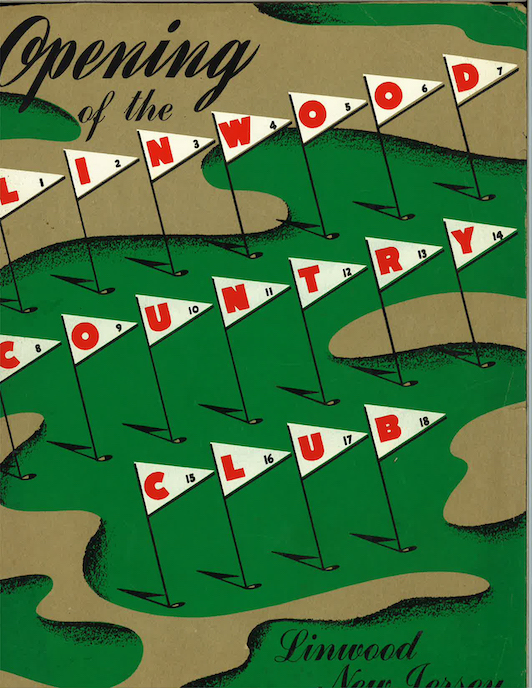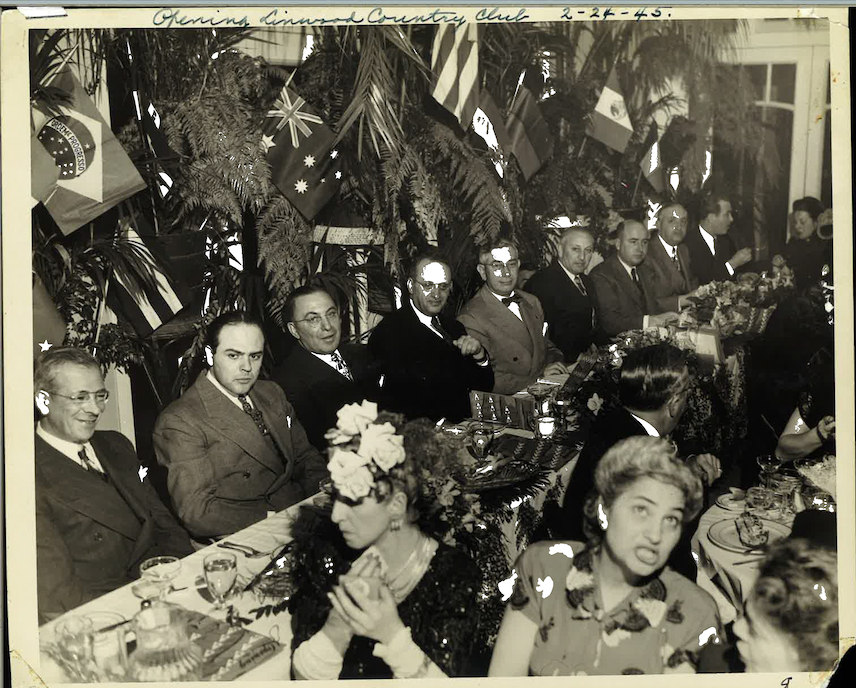Celebrating over 100 years of tradition
The Clubhouse was designed by the architect who built the Traymore Hotel in Atlantic City. It was built of hollow tile coated with white stucco and topped with a green roof. Turrets were integral to the original design and persist to this day although parts of the old building have been surrounded by additions erected through the ensuing years. The clubhouse was planned to sit on a knoll so that many parts of the golf course could be seen from the building. A large ballroom was planned, as was an indoor swimming pool. No plans for a driving range were included.
The original tract of land that was purchased was over 250 acres and consisted of ten separate tracts. The
total estimated cost for buildings and course was $300,000.

The golf course was officially opened, although building construction was not complete, with a golf tournament on March 20, 1921 and the laying of the cornerstone. A group photograph of the laying of the cornerstone is on the wall of the old bar by the entrance of the ladies locker room. The original cornerstone is enclosed by internal walls related to the construction of 2000 and is near the closet in the card room adjacent to the bar.
Much of the current structure was created by additions and remodeling of the original clubhouse. The history is visible by observing the multiple roof lines which are apparent from the second floor of the main building.


IThe history of Linwood Country Club after its grand opening in 1921 has been clouded by the lack of in house written records, some of which were destroyed in a fire. Unfortunately, many of the long range plans of the original planners were beset by circumstances that were not envisioned at the start.
The onset of Prohibition in 1920 was not conducive to the profitable operation of a country club. The onset of the Great Depression struck a second unsustainable blow and the club could not keep up with paying off its indebtedness and ended up in receivership, ceasing all operations after a futile attempt to run the course as a public course. The onset of the Second World War drastically depleted the potential users of Linwood Country Club and all ideas of reopening were held in abeyance. The clubhouse was boarded up for many years until 1944. As the Depression abated, the interest of restarting the club sparked a group of thirty-four men to meet on December 7, 1943 at the Jewish Community Center on Virginia Avenue in Atlantic City to discuss the possibilities. The club was repurchased from receivership for $23,500.
The club grew in membership with the return of World War II veterans and many of the improvements both to the clubhouse and golf course were accomplished during this era. As in all ventures of this kind, the continued need for financial backing persisted and in 1960 a rather complicated method of raising funds by issuing stock in a new entity “Linwood Country Club” was introduced. In order to reduce the risks to the members of the new entity and create an investment opportunity for the members, Linwood Country Club leased the clubhouse and the operation of the golf course from the Linwood Golf and Country Club. The lease was for 99 years expiring in 2059. Linwood Golf and Country Club therefore owns the property including the golf course and clubhouse but Linwood Country Club operates the golf, tennis and clubhouse functions.
In 1971 a major reconstruction enlarged the dining room to 5,200 square feet actually doubling the size, including a terrace and corridor. The capacity was increased to 300 persons plus a dance floor as well as a new bar adjacent to the men’s locker room. In 2001, the club house was again expanded to accomodate our current dining room, bar and additional event facilities.
In 1976, a proposal was made to the Board for construction of tennis courts. At the same time negotiations were made with the Linwood City Council to vacate Poplar Avenue from Woodlynne Boulevard to a point east of the third hole. In return for vacating the road which ran through the course, LCC traded the land for the pumping station which exists to the left of the men’s third tee. This gravel road still exists in the memory of former golfers who ask, “is that road still there?”
Perhaps the most apparent change in the golf course was the result of the 1999 reconstruction which allowed the development of the driving range. Until this time, the driving range was the stepchild of Linwood Country Club. There was never a real range but several attempts were made to “make-do”. Each attempt squeezed out a few hundred yards by hitting perpendicular to and across the fifth fairway from the unused land near the Off property and targeting the present short range. Fortunately no serious injuries were recorded. The present range required movement of the existing ninth fairway to the east to reach the ninth green, the complete renovation of the tenth hole and the development of an artificial pond. The driving range has become a most popular addition and a great advantage for old and young who wish to improve their game.
The 1999 reconstruction included modifications to every hole. Tony Lepre and Rob Salad were the architects who redesigned the entire golf course. Their mission included utilizing our unique seaside setting and spectacular vistas to create the wonderful aesthetics that exist today. The addition of large waste bunkers with native grasses complements the natural marshes on which the course is situated. The goal for playability was and remains to provide our members and their guests with a user friendly yet challenging facility in which the beauty and wildlife of the Jersey shore may be enjoyed. The redesign included a lengthening of the championship tees and the creation of four sets of tees. Toward this end, Tony and Rob, ably assisted by Alan Beck and Jeff LeFevre, accomplished the twin goals of making it more difficult for an accomplished player to break 80 from the championship tees while making it easier for the average player to break 100.
In December 2017, Linwood Country Club was purchased by a small group which includes the Dougherty family. A local family, the Dougherty’s bring their highly successful experience in the restaurant industry, as owners of Dock’s Oyster House and Knife & Fork Inn in Atlantic City.
The new ownership brought a myriad of renovations, including the addition of a luxurious bridal suite, updated finishes and lighting in the banquet room, the installation of a movable glass “wall” anchored by a double sided fireplace and the creation of a dramatic entry into the club from Shore Road. These changes, as well as the revamped food and beverage options and extended dining hours, enticed many new members and expanded the Club’s reputation as a premier venue for events.
The Dougherty’s vision is to enhance the experience for existing members, attract new members and provide unparalleled event space to make Linwood Country Club the top golf event destination in the area.
